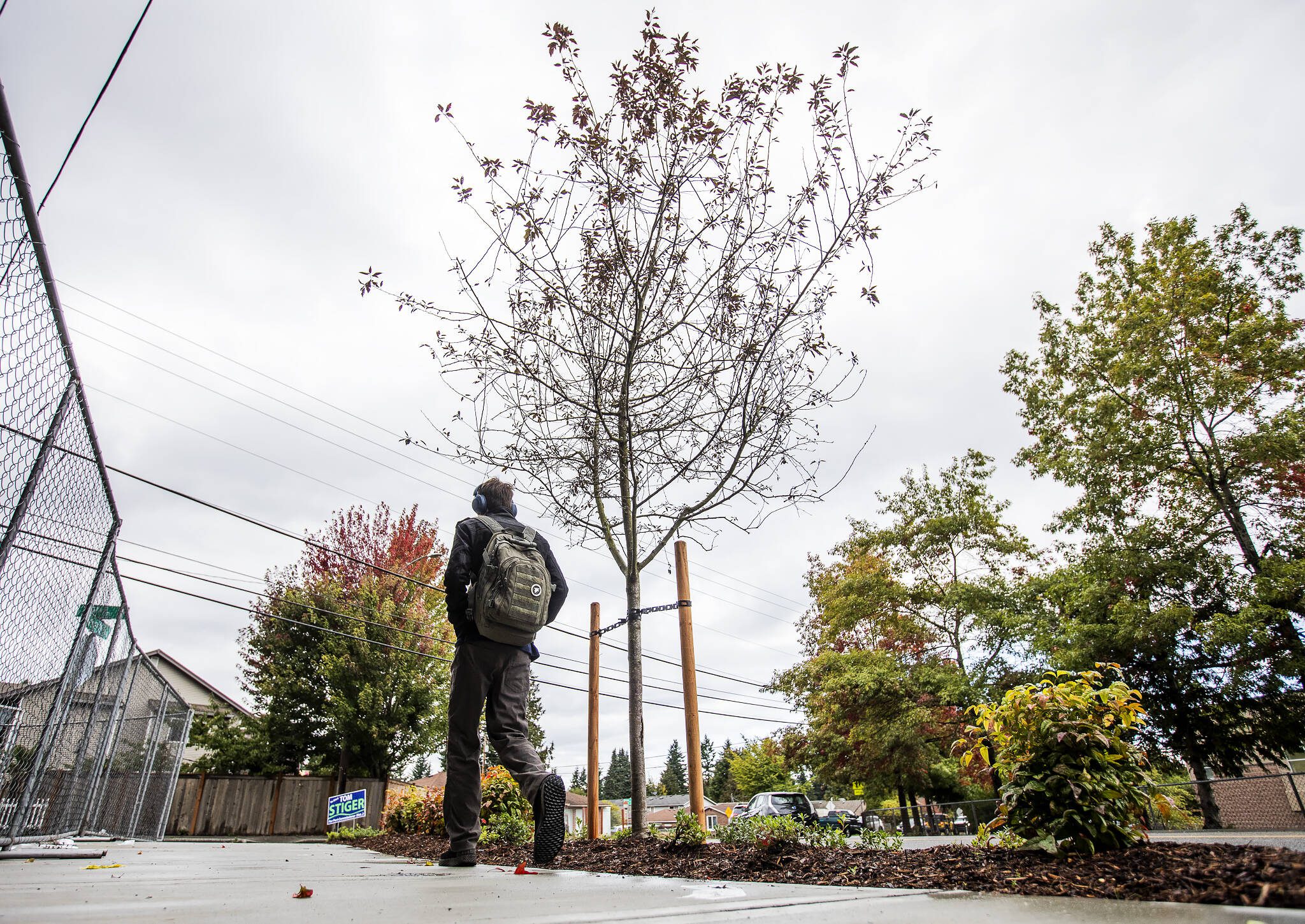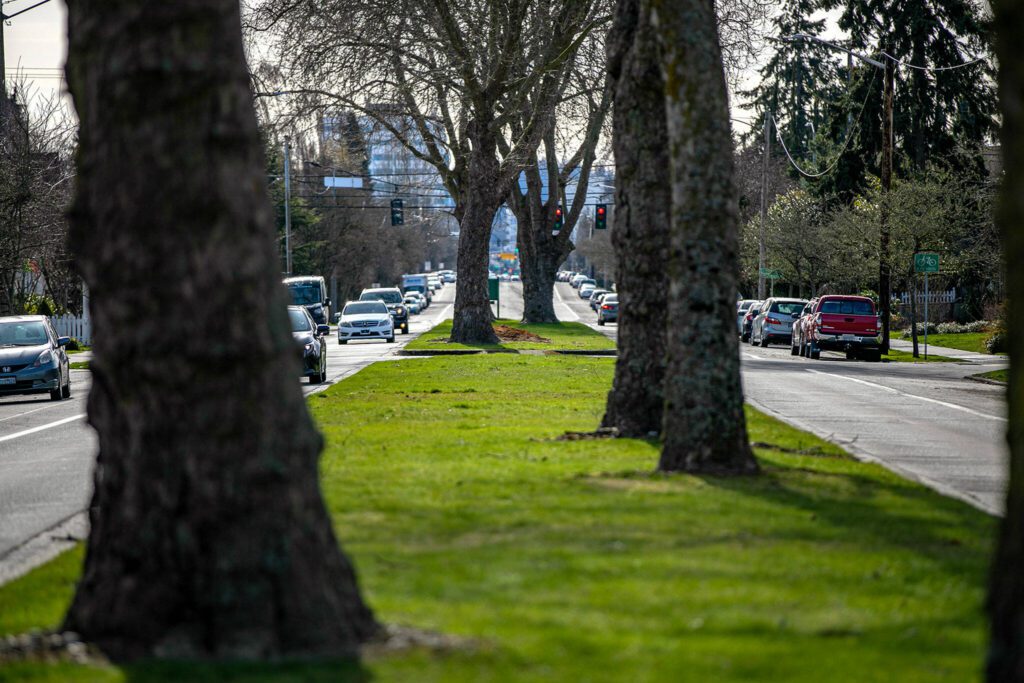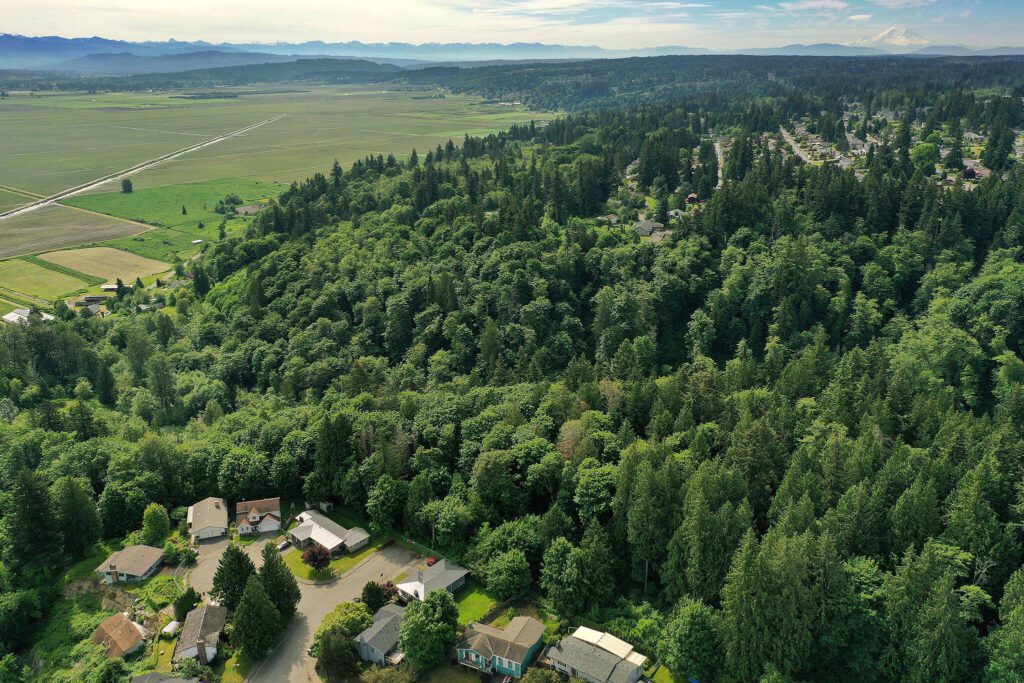EVERETT — Thousands of trees are coming to urban areas in western Snohomish County.
Federal grants are giving the Snohomish Conservation District and the city of Lynnwood a total of $3.7 million for separate urban forestry projects. That means more trees in Everett, Marysville, south Lynnwood and the Tulalip Reservation.
Research suggests urban trees can counteract the “urban heat island” effect, improve mental health and generally improve the environment. They can also divert stormwater and help with erosion as their roots hold soil together and take in water.
The new trees are going to areas with little canopy cover.
“We’re doing 100% underrepresented communities,” said Linda Lyshall, the executive director of the Snohomish Conservation District. “We really wanted to address that tree equity concern, where you have urban areas where there’s just no greenery.”
In 2021, The Nature Conservancy reported in 92% of U.S. communities, poor neighborhoods had less tree cover than affluent neighborhoods. The same year, American Forests, a national nonprofit conservancy group founded in 1875, released its “Tree Equity Score map” tool showing which census blocks have fewer trees.
The Tulalip Tribes will determine where trees go based on community input, said Valerie Streeter, a stormwater planner for the tribes who has worked on the project with the Snohomish Conservation District.
“I cannot say at this point how many trees were estimated,” Streeter wrote in an email. “Parts of the Tulalip Reservation are well forested while some areas do not have much tree cover. Outside of Quil Ceda Village, we will be looking at tree canopy coverage to target which neighborhoods to approach.”
L5-tulalip
Marysville will plant trees downtown. City officials did not know how exactly many trees will be planted.
The Lynnwood project will focus on the Cedar Valley neighborhood.
Two census blocks in the Delta neighborhood in Everett and five in the south Everett area around the Casino Road, Holly and Evergreen area are being targeted for saplings, said Kimberly Moore, the city’s assistant parks director.
“We’re going to attempt to plant about 1,000 trees in each census block,” Moore said — or a little bit less than a tree per person, on average. “We’re hoping over the years, as those trees grow, they can make a big difference in our urban tree cover.”
‘An unprecedented investment’
The 2021 Inflation Reduction Act put $1.1 billion in federal money toward urban and community forest projects.
Of the 842 applications for that pot of money, the U.S. Forest Service selected 385 — including the Snohomish Conservation District and Lynnwood projects. The U.S. Forest Service said the total amount of grant money requested in those 842 applications totaled $6.4 billion.
The state is also investing in urban forests, making $7 million available for urban forestry through the Community Forest Assistance Grant program, Commissioner of Public Lands Hilary Franz said in an interview with The Daily Herald. That is 11 times more than DNR’s Urban and Community Forestry program has ever had to award, a spokesperson said.
Franz has advocated for a more equitable distribution of trees.
“Washington State and the Forest Service have, for too long, not had adequate funding to actually be investing in our urban areas and urban canopy,” Franz said. “For the first time you see an unprecedented investment by our own state and being able to provide that funding. It also coincides with our push and work to get the federal government to also be investing in that Inflation Reduction Act.”
A state tool, called the health disparities map, is part of what’s being used to dial in on which neighborhoods are environmentally underserved. The federal government has a separate database serving a similar purpose.
Both help federal and state authorities make decisions on where money should go.
“All state programs in one form or another are working towards the same types of activities to meet the expectations at the federal level,” said Ben Thompson, the urban and community forestry program manager for DNR. “In that way, we’re all connected, we’re all working on the same stuff, we’re all interested in the same types of projects and types of work and the same outcomes.”
As part of the push toward tree equity, the state entered into a partnership with American Forests last year. The program, called the Washington Tree Equity Collaborative, is spending three years to “engage” cities and build forestry programs.
The tree equity tool is not complete, but many residents could get a pretty good idea of where their neighborhood stands.
“You could hold it up and show it and you can point people and direct to it and say, ‘Hey, this is where the disparities are in our community from a tree equity perspective,’” Thompson said. “And like, let’s start this conversation, let’s start working on this and looking at it.”
The tree equity problem stems back to redlining issues through the 20th century, Franz said. Low-income neighborhoods, as well as those where more people of color lived, were less likely to get money for local improvements.
“We are known as the Evergreen State and we’re known for that because of our amazing forestlands,” Franz said. “We have for too long have ignored our urban areas and our trees in urban areas.”
More drastically, major highways and roads cut through many of these neighborhoods historically. Asphalt and concrete suck in heat and stay warm for long periods of time.
A 2020 study looking at 108 metro areas found temperatures in redlined areas average 4.7 to 12.6 degrees warmer than areas that were not redlined.
“Investments were made in wealthier, white neighborhoods around greening, parks and tree canopy,” Franz said. “While not making those investments in lower income and communities of color.”
‘True tree equity’
There are over 5,400 trees on city of Everett property, according to the 2023 Everett Park Tree Inventory Report.
According to the report, “inventoried park trees are providing approximately 0.73 square miles (468.1 acres) of canopy cover, which accounts for 2.18% of total land area.” Everett covers 33½ square miles of land.
In 2021, Everett’s estimated tree canopy covered about 25% of public and private land within city limits.
Around 6% of the tree canopy in Everett is on city property, while the rest is privately owned, said Moore, the assistant parks director. This makes increasing greenery a bit more challenging.
“The city of Everett can’t go and plant trees on private property,” Moore said. “That’s where the partnership with Snohomish Conservation District comes in.”
Over the next few years, representatives from the tree project will meet with residents set to receive trees, Lyshall said. There will be chances for neighborhoods to help decide both the type and location of trees.
Exactly what type of trees will be placed remains to be seen. They will likely be drought resistant, Lyshall said. Some of what’s planted might be edible.
The Everett tree report found 112 varieties on city land. Over 20% of those were Douglas firs.
“We’re trying not to plant any more of those for a while,” Moore said.
The trees that do end up planted have to come from somewhere. And that is a logistical challenge due to the sheer number of plants needed. Some scientists are concerned the United States is not producing enough trees to meet planting goals.
The Snohomish Conservation District has its own tree nursery, though the district could potentially contract out to local nurseries. The Department of Natural Resources also has its own facility in the Webster Forest Nursery, but those trees are mostly for replanting areas burned by fire or other reforestation needs.
For urban tree equity, Washington needs to plant 13.5 million trees, Franz said.
“We recognized that we’re going to have to be investing in our nursery capacity,” she said, “if we’re going to actually get to true tree equity in every single neighborhood in the state.”
Jordan Hansen: 425-339-3046; jordan.hansen@heraldnet.com; Twitter: @jordyhansen.
Talk to us
> Give us your news tips.
> Send us a letter to the editor.
> More Herald contact information.





























